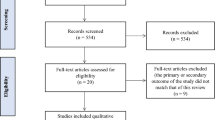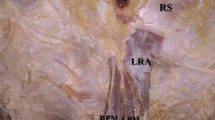Abstract
Purpose
The goal of the study is to analyze the morphometric diversity of the pyramidalis muscle (PM) and to evaluate how it is affected by gender and side of occurrence.
Materials and methods
Ninety-six (50 male and 46 female) formalin-embalmed Greek cadavers were dissected.
Results
The PM was present in 93.8 %, usually bilaterally (79.2 %) than unilaterally (14.6 %) (p = 0.003) and more frequently in females (91.3 %) than in males (68 %) (p = 0.0001). Side symmetry was detected. The mean length of PM in males and females was 8.37 ± 2.80 and 6.18 ± 1.64 cm on the right and 7.50 ± 2.66 and 6.56 ± 1.68 cm on the left side. Male predominance existed on the right and left-sided PM lengths (p = 0.0001 and p = 0.054). The mean width of the right-sided PMs in males and females was 1.61 ± 0.55 and 1.50 ± 0.44 cm and the left-sided 1.56 ± 0.53 and 1.55 ± 0.38 cm without gender dimorphism. The positive correlation between the PM length and width indicates a symmetrical muscle augmentation on the two dimensions.
Conclusions
The study demonstrates that the PM is almost constant in Greeks. Among populations the muscle morphometric variability, its clinical significance and its variable uses will help surgeons when intervening in the lower abdominal wall.



Similar content being viewed by others
References
Adachi B (1909) Beiträge zur Anatomie der Japaner XII. Die Statistik der Muskelvarietäten. Zeitschr Morphol Anthropol 2:261–312
Anson BJ, Beaton LE, McVay CC (1938) The pyramidalis muscle. Anat Rec 72:405–411
Ashley-Montagu MF (1939) Anthropological significance of the musculus pyramidalis and its variability in man. Am J Physical Anthopol 15:435–490
Attinger CE, Ducic I, Cooper P, Zelen CM (2002) The role of intrinsic muscle flaps of the foot for bone coverage in foot and ankle defects in diabetic and nondiabetic patients. Plast Reconstr Surg 110:1047–1057
Beaton LE, Anson BJ (1939) The pyramidalis muscle: its occurrence and size in American whites and Negroes. Am J Phys Anthropol 25:261
Chouke KS (1935) The constitution of the sheath of the rectus abdominis muscle. Anat Rec 61:341–349
Chudzinski T (1898) Observations sur les variations musculaires dans les races humaines. Mem Soc Anthrop, Paris XI, pp 1–223
Cruveilhier J (1880) Traite d’Anatomie descriptive II, Paris, p 8
Czeckanowski J (1906) Zur Frage der Correlationen der Muskelvarietaten. Boas Anniv 45:43–54
Dickson MJ (1999) The pyramidalis muscle. J Obstet Gynaecol 19:300
Didia B, Loveday O, Christian I (2009) Variation and frequency of agenesis of the pyramidalis muscles in Nigerian males. J Exp, Clin Anat 8
Dwight T (1893) Observations on the psoas parvus and pyramidalis. A study on variation. Proc Am Phil Soc 31:117–123
Garvey JF (2012) Computed tomography scan diagnosis of occult groin hernia. Hernia 16:307–314
Goss CM (1948) Fasciae and muscles of the abdomen. Gray’s anatomy, 29th edn. Lea & Febiger, Philadelphia, pp 424–427
Gürbüz-Malcic J, Özdoğmuş O, Yüksel M (2001) Unusual rectus abdominis and pyramidalis muscles: clinical significance—a case report. MMJ 14:107–109
Hinoul P, Roovers JP, Ombelet W et al (2009) Surgical management of urinary stress incontinence in women: a historical and clinical overview. Eur J Obstet Gynecol Reprod Biol 145:219–225
Jurascheck F, Dollfus P, Chapuis A et al (1987) Surgical treatment of the static perineal modifications in spinal cord or cauda equina lesions. Paraplegia 25:475–481
Jyothilakshmi TK, Sarala HS, Gautham BV (2013) Anatomical significance of the nerve to pyramidalis muscle: a case report. Anatomica Karnataka 7:41–44
Koganei Y, Arai H, Shikinami J (1903) Varietatenstatistik der musculn. Tokyo Igakkai Zasshi 17:127–139 (in Japanese with German abstract)
Koulouris G (2008) Imaging review of groin pain in elite athletes: an anatomic approach to imaging findings. AJR Am J Roentgenol 191:962–972
LeDouble AF (1897) Traité des Variations du Système Musculaire de l’Homme et Leur Signification au Point de vue de l’Anthropologie Zoologique. Libraire C. Reinwald, Scheicher Frères, Paris, pp 583–587
Loth E (1912) Beiträge zur Anthropologie die Negerweichteile (Muskelsystem), Stuttgart, p 98–99
Lovering RM, Anderson LD (2008) Architecture and fiber type of the pyramidalis muscle. Anat Sci Int 83:294–297
Monkhouse WS, Khalique A (1986) Variations in the composition of the human rectus sheath: a study of the anterior abdominal wall. J Anat 145:61–66
Nakamura S (1935) Ueber den M. rectus abdominis und den M. pyramidalis der Japaner (am Kynahu). J Kumamoto Med Soc 11:1251–1261
Nakano T (1923) Beiträge zur Anatomie die Chinesen. Die Statistik des Muskelvarietäten. Okajimas’ Folia Anat Jap 1:273–282
Natsis K, Repousi E, Noussios G et al (2014) The styloid process in a Greek population: an anatomical study with clinical implications. Anat Sci Int 90:67–74
Schwalbe G, Pffitzner W (1889) Variet Statistik und Anthropologie. Anat Anz 4:705–714
Sippo WC, Gomez AC (1987) Nerve-entrapment from lower abdominal surgery. J Fam Pract 25:585–587
Sumino Y, Hirata Y, Hanada M et al (2011) Long-term cryopreservation of pyramidalis muscle specimens as a source of striated muscle stem cells for treatment of post-prostatectomy stress urinary incontinence. Prostate 71:1225–1230
Thomson A (1895) Fifth annual report of the committee of collective investigation of the anatomical society of Great Britain and Ireland for the year 1893-94. J Anat Physiol. 35-60
Tokita K (2006) Anatomical significance of the nerve to the pyramidalis muscle: a morphological study. Anat Sci Int 81:210–224
Vallois HV (1926) Valeur et signification du muscle pyramidal de l’abdomen. Arch Anat Histol Embryol 5:497–525
Van Landuyt K, Hamdi M, Blondeel Ph et al (2003) The pyramidalis muscle free flap. Br J Plast Surg 56:585–592
Winslow M (1875) Exposition Anatomique de la Structure du Corps Humain. T. IV, Paris, p 45
Author information
Authors and Affiliations
Corresponding author
Ethics declarations
Conflict of interest
The authors declare that they have no conflict of interest.
Rights and permissions
About this article
Cite this article
Natsis, K., Piagkou, M., Repousi, E. et al. Morphometric variability of pyramidalis muscle and its clinical significance. Surg Radiol Anat 38, 285–292 (2016). https://doi.org/10.1007/s00276-015-1550-4
Received:
Accepted:
Published:
Issue Date:
DOI: https://doi.org/10.1007/s00276-015-1550-4




